Aiming to bridge the travel divide
Table of Contents
1. Thinking through the Continued Zero Sales
3. Frequency of travel among seniors has declined sharply
4. Traveling is the No. 1 hobby of seniors
5. Travel lowers dementia risk
6. Invisible handicapped accessible to Travel for the Disabled
7. Family travelers show a sharp decline in overseas travel
8. Family international travel extends children’s curiosity
9. Travel Divide among Millennials
1. Thinking through the Continued Zero Sales
We have had zero sales since the company’s inception on December 7, 2021. Naturally, we are in the red for our costs. The reason is due to the inability of individual foreign tourists to come to Japan due to COVID-19.
Europe, the U.S., and some Asian countries reopened overseas travel since spring 2022. We had expected that the Japanese government would ease the entry of individual foreign tourists in the fall of 2022. However, we must say that the easing of re-entry in the fall of 2022 has become more difficult by increasing the number of COVID-19-positive since mid-July (the 7th wave). Our deficit will continue until the easing of immigration.
I’ve thought a lot since we established our company under these difficult circumstances. Of course, we also considered our “Purpose ,” “Mission (Management Philosophy),” and “Vision“. These are “to create a society where everyone can move freely and make people happy,” “(1) value diversity and bring out creativity, (2) overturn common sense and solve problems and challenges, (3) strive with integrity and conduct business ethically,” and “create the future travel,” respectively. The “Future Travel” means going abroad with only a passport and a smartphone.

2. What is the Travel Divide?
Through much thought, we have come to the conclusion that a “a society where everyone can move freely” is a “society in which we eliminate the travel divide.”

The term “travel divide” was coined by us, inspired by the term “digital divide.
As you know, the “digital divide” is the disparity between people access to information and communication technologies (ICT) such as the Internet and people do not. In the travel industry, some people want to travel but cannot. In other words, the “travel divide” is the gap between those who can travel and those who cannot.
The “travel divide” includes people who can’t travel due to financial problems. However, many people can afford to travel but can’t do so because of the burden of carrying luggage.
In particular, the elderly, people with disabilities, and families with small children have to give up travel because of the burden of carrying luggage, even if they want to go on vacation.
Although the elderly and the disabled are generally distinguished, according to the Cabinet Office, 72.6% of the disabled at home are 65 years old or older (2016). 3.1 millions disabled people aged 65 or older live at home.
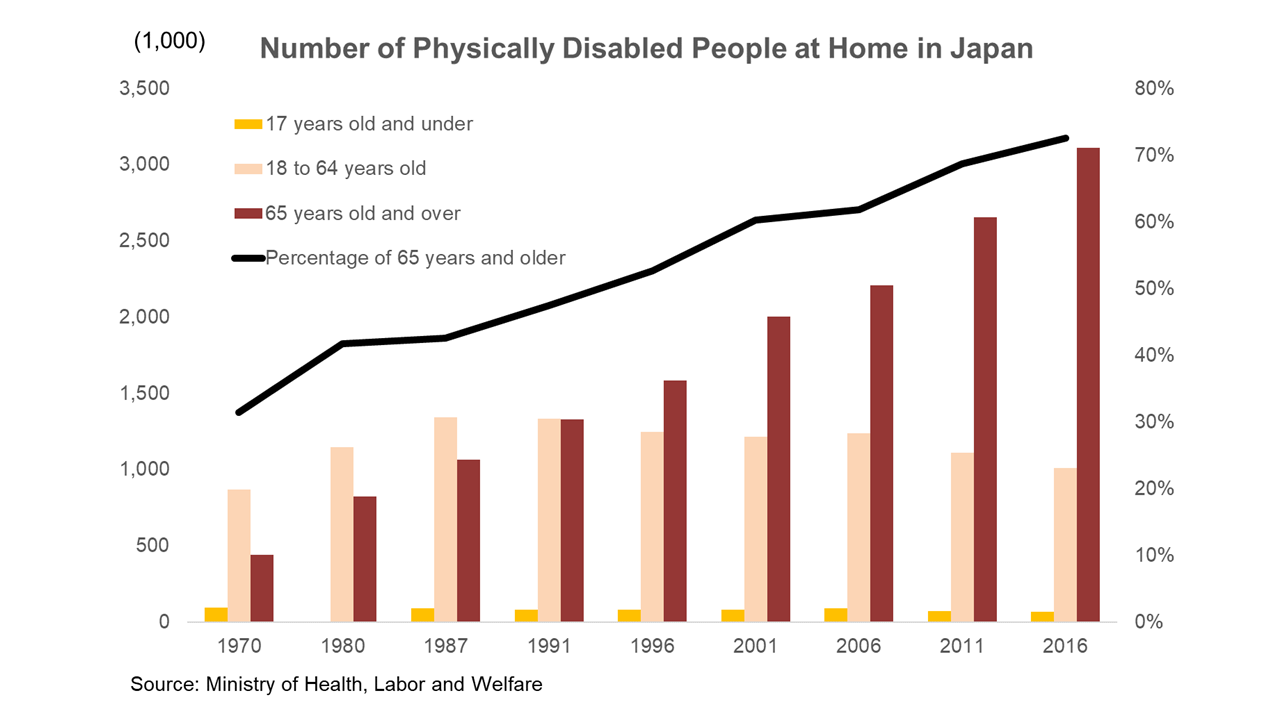
According to the United Nations, “about 15% of the world’s population, or 1 billion people live with disabilities.” The number of disabled persons will increase by medical treatment advances and the population ages. As the aging of the population is inevitable, the number of people with disabilities in Japan and around the world will increase.
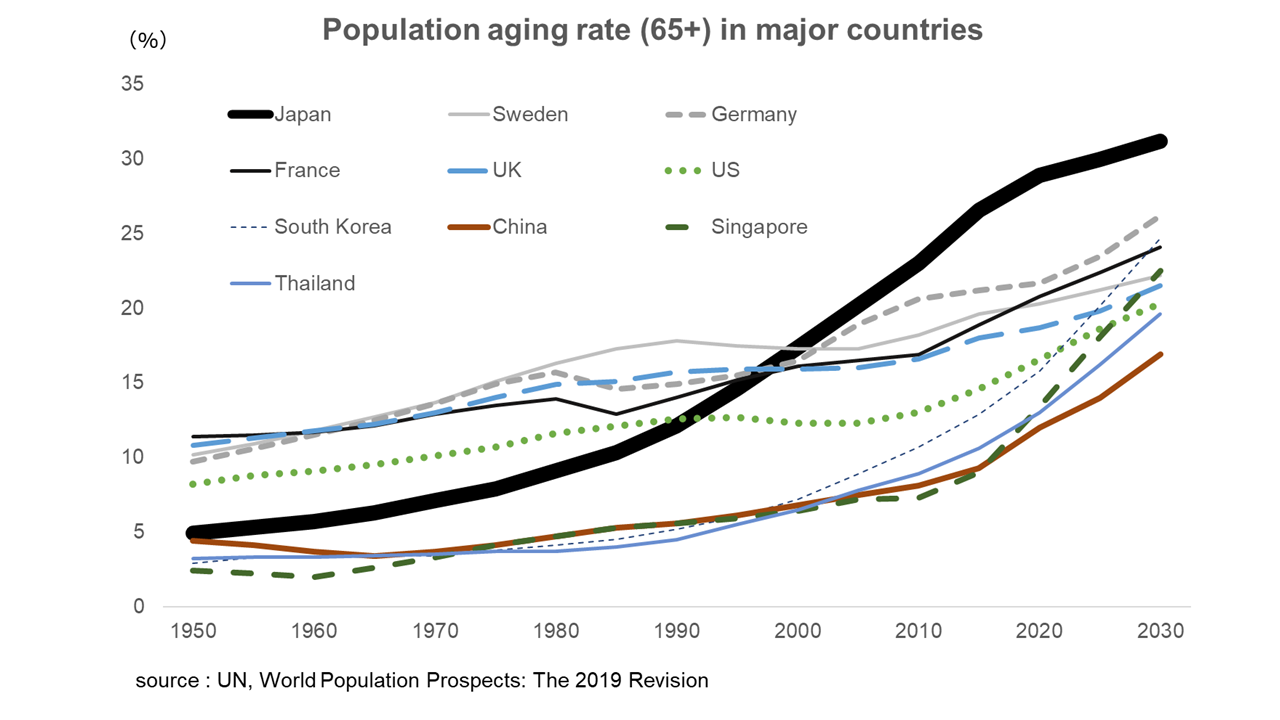
It is necessary to recognize that all young non-handicapped people “will surely eventually become elderly and therefore likely to become disabled.” They may suddenly become mobility impaired one day due to an accident or other unforeseen circumstances. Becoming a person with mobility difficulties is not someone else’s problem, but everyone’s problem.
3. Frequency of travel among seniors has declined sharply
The number of trips taken by seniors ages 70 and older declines sharply: in 2019, domestic trips are down 34%, international trips are down 72% relative to the average number of trips taken.
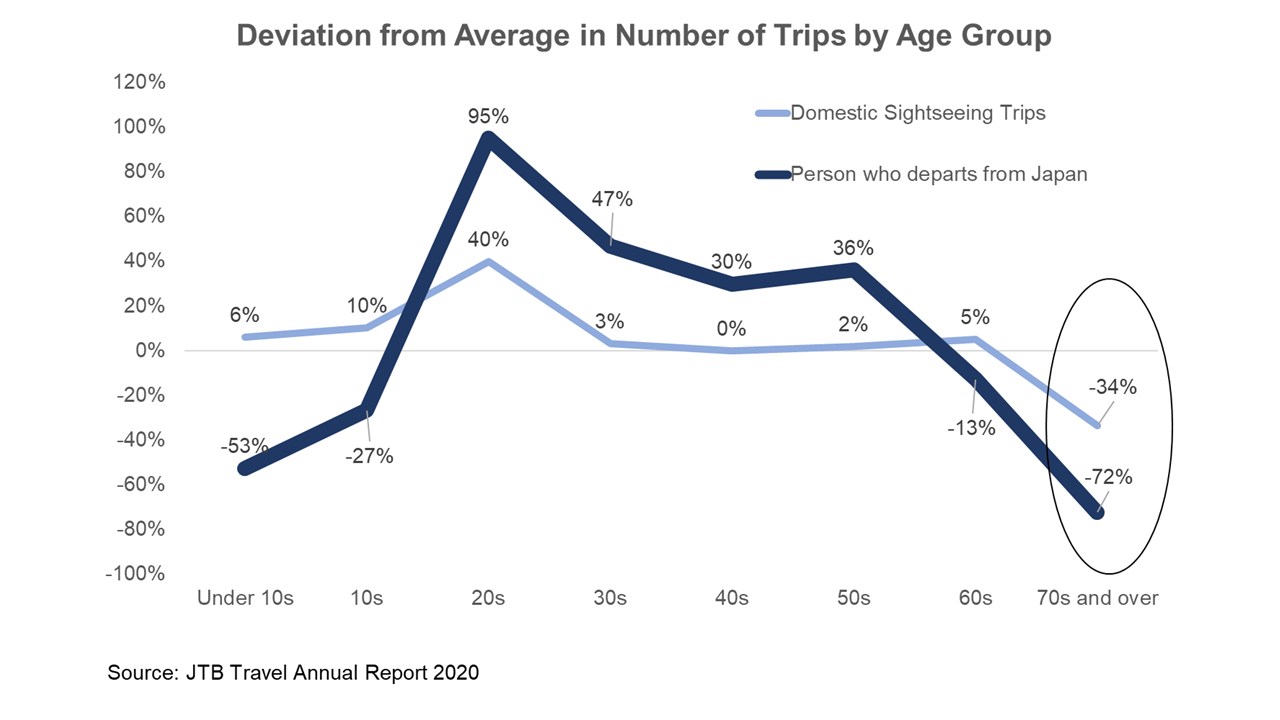
Unless accessible tourism, which makes it easier for the elderly, disabled, and others with mobility challenges to travel, is established as soon as possible, the overall number of tourists will inevitably decline along with the aging of the population.
As described below, bridging the “travel divide” will lead to solutions to social issues and make many people happy.
4. Traveling is the No. 1 hobby of seniors
Many seniors cite travel as a hobby, and according to Sony Life Insurance’s “Senior Lifestyle Awareness Survey 2021 (responses from 1,000 senior men and women aged 50-79 nationwide)” released on September 8, 2021, “Travel” (44.6%) ranked first among their “Current Pleasures.” It was followed by “TV/drama” (36.0%) in second place, “Movies” (26.7%) in third, “Gourmet food” (25.4%) in fourth, and “Reading” (24.2%) in fifth.
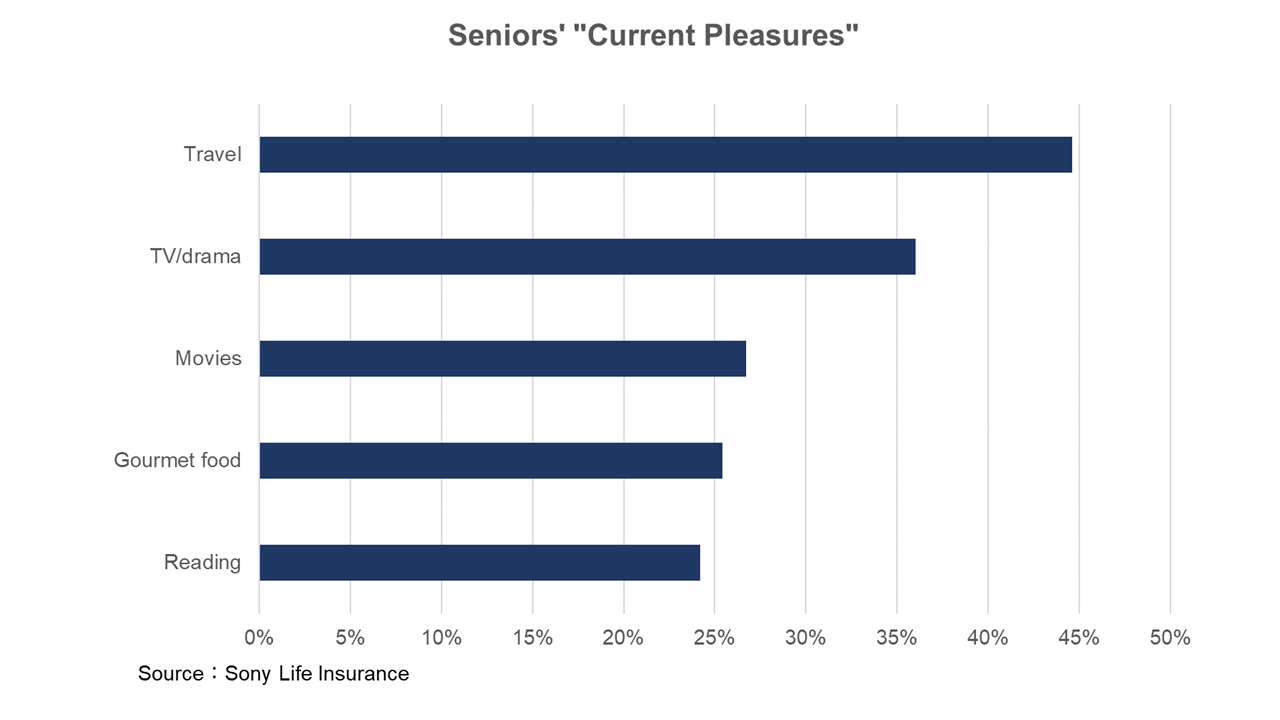
Interestingly, the number of seniors who cited “travel” as a current pleasure rose from 43.4% in the 2020 survey to 44.6% in 2021, indicating that travel is a considerably stronger pleasure given the prevalence of COVID-19 infection.

Nonetheless, as noted earlier, the sharp decline in the number of trips by the elderly (pre-COVID-19 data for 2019) means a significant increase in the number of people who want to travel but cannot.
5. Travel lowers dementia risk
A joint study by Club Tourism Co., Ltd. and Tohoku University has confirmed “the possibility of reducing the risk of dementia in travel“. It was confirmed that “diffuse curiosity,” a form of intellectual curiosity, is the motivation for travel, and the mechanism by which “subjective well-being” is increased by cognitive stimulation through travel was elucidated. Interestingly, joint research shows that travel increases happiness and decreases the risk of dementia.
According to the World Health Organization (WHO), “More than 55 million people worldwide are living with dementia, with nearly 10 million new cases each year. Dementia is the seventh leading cause of death among all diseases and one of the leading causes of disability and resulting care dependency among the elderly worldwide”.

According to the Ministry of Health, Labour and Welfare, “The number of people over 65 years old with dementia in Japan will be about 6 million (in 2020), and they predicted that about 7 million people (about 1 in 5 elderly people) will have dementia by 2025. As Japan’s population ages, efforts to prevent dementia will become increasingly important.

They estimated the number of dementia patients in Japan will increase to 7.44 to 8.3 million in 2030 and 7.97 to 10.16 million in 2050. According to a Keio University study, the annual social cost of dementia amounts to 14.5 trillion yen (announced May 29, 2015). In addition, many young caregivers have family members with dementia. Increasing the number of trips is essential to solving the problem of young caregivers, which has become an issue in recent years.
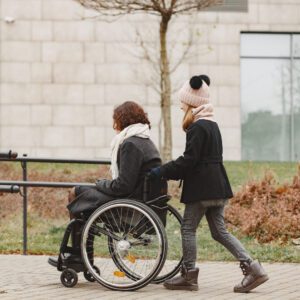
Thus, if the number of trips made by the elderly and disabled, who are the “mobility impaired,” increases, it is expected that the number of dementia patients will decrease, leading to reductions in medical and social security costs.
There is an urgent need to eliminate the “travel divide” for the elderly and disabled, which is likely to involve even family members of dementia patients.
6. Invisible handicapped accessible to Travel for the Disabled
According to a paper by Tetsuo Akiyama and others, “Universal Tourism for the Difficult-to-Tourist Class,” 38% of respondents ranked “price” first in a survey of dissatisfaction with travel products among the disabled and elderly. The cost of travel is two to three times higher than that for non-handicapped people due to the need for a caregiver is an “Invisible handicapped accessible.”
The second most common complaints were “attractiveness of tour content” and “handicapped accessible accommodations” (both 24%). We, non-handicapped people, do not fully understand the dissatisfaction with “price,” which ranks higher than dissatisfaction with handicapped accessibility. We urgently need to establish the way to reduce the number of carers when disabled people travel.

The Tokyo 2020 Paralympic Games made significant progress in eliminating steps at stations and other public facilities, “making visible handicapped accessible,” which is a valuable legacy. The next step is to “identify where is the difficulty of handicapped accessible in society? The next step is to evolve universal design through “invisible handicapped accessible” by always being aware of “where are the difficulty of handicapped accessible? I believe that a “socially inclusive” society is one in which all people can “move easily.”
7. Family travelers show a sharp decline in overseas travel
The preceding chart, “Deviation from Average in Number of Trips by Age Group,” does not allow us to understand whether the drop in family travel is larger or smaller than the average for overall travel. However, we can see that international travel (based on outbound travelers) for under-teens and teens has declined significantly (-53% and -27%, respectively, 2019 data).
Family travel has dropped significantly in overseas travel. Overseas travel is less frequent than domestic travel, because the travel cost is higher than domestic travel, etc. The JTB Travel Annual Report 2020 surveyed a sample size of 6,232 for domestic travel and 4,002 for overseas travel. Simply assuming that the number of overseas travelers decreased 36% (from 6,232 to 4,002) compared to domestic travelers, as per the sample size, we examined the divergence of the decline by market segment.
As a result, at the large category, “Travel with friends” showed a smaller decline than the average decline. “Travel with friends” was less affected than the average, while “Travel as a couple” was about the same as the average. However, “Family travel” was down 11%, and the subcategories “Travel with infants” and “Travel with elementary, junior high, and high school students” were down 27% and 16%, respectively.
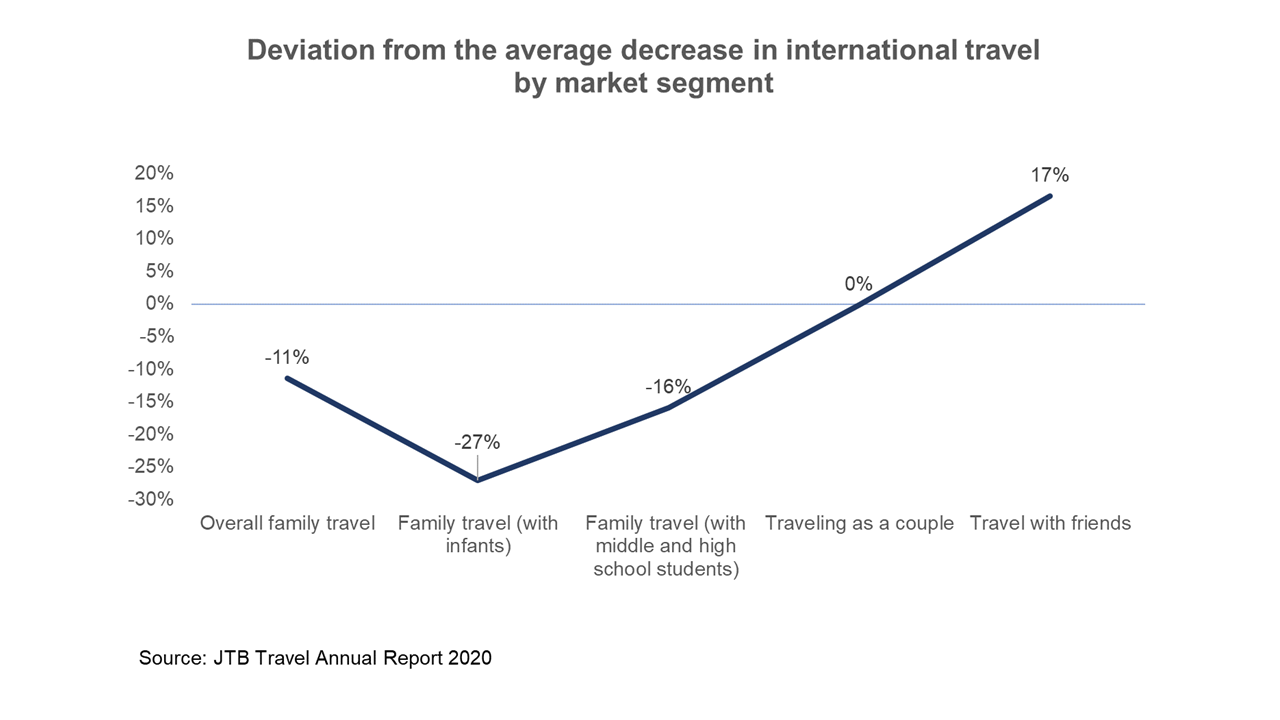
Of course, the main reason for the drop in family international travel compared to domestic travel is probably the inability to make travel expenses from a financial standpoint due to the large number of family members traveling together. However, another JTB survey (released on March 9, 2007) reveals that there are various problems other than financial ones. The No. 1 problem in preparing for an overseas trip was “preparing luggage” (22%). Also, 48% of respondents ranked “putting away luggage” as the most troublesome thing to do after returning from a trip. Women also find “taking care of family members” a hassle after being free from household chores during the travel.

In test marketing conducted by our company at TOKYO Start-up Station TAMA (Tachikawa City) (September 2021), as many as 90% of the respondents felt dissatisfied with or burdened by luggage (preparation, transportation, laundry, and storage) when traveling abroad.
Of course, housework is not the sole job of women. Still, women bear a heavy burden. On average, women spend 1.9 times as much time on housework as men in OECD, and a whopping 5.5 times as much in Japan (source: OECD Time of Living International Comparison Data 2020). All 14 countries surveyed indicated that women do more housework than men.

Eliminating the unnecessary housework of preparation and cleanup before and after international travel would significantly reduce the burden on women and increase the likelihood of family travel by households raising children.
8. Family international travel extends children’s curiosity
Some people said that better opportunity to develop children’s curiosity is “traveling abroad” to experience different cultures. According to Yasushi Ogasawara, professor at Meiji University’s School of Global Japanese Studies, “It is important to give children experiences that expose them to various societies, such as traveling abroad, to make them reconsider their common sense (Source: President Online, June 7, 2019, “The Real Reason for “Let the Pretty Child Travel”).
In addition, Associate Professor Akimi Morishita of Toyo University reported in a survey that children who had more family travel experiences while growing up were more satisfied with their character and orientation in adulthood. She says that family travel experience to overseas is effective in the formation of human qualities. Human qualities are “adaptability,” “independence,” “communication skills,” “sociability and sociality,” and “compassion and mental stability.” Source is “The Effects of Overseas Family Travel on Children, March 2021.”

If families with small children can’t travel even if they want to, and if it affects their children’s curiosity and human development, then it is safe to assume that there is a strong “travel divide” as well as for the elderly and the disabled. We need to eliminate the “travel divide,” here too.
9. Travel Divide among Millennials
In addition, 32% of millennial travelers surveyed by Hotels.com in 26 countries cited “pre-planning a trip as one of the biggest stresses in their lives.” More than one in seven spend 20 hours or more searching for travel plans. In addition, 25% have given up on a trip due to search fatigue, and 36% would “pay a friend about Yen 20,000 to search for them. Millennial travelers in Japan also say that 47% are “fed up with considering different options” and 61% are “overwhelmed by the number of possibilities.

The “too many choices” of travel is a “Paradox of choice” in which more choices make people more unhappy. This paradox will worsen with each passing year unless the information overload of the Internet society recedes.
The “travel divide” is also a factor in the decline in subjective happiness among millennials, who can’t travel even if they wanted to due to the stress of creating travel itineraries and other factors.
10. Conclusion
As described above, a “travel divide” exists for many people, and society will be required to work to eliminate this divide. We aim to eliminate the “travel divide” for our “Purpose,” “create a society where everyone can move freely and make people happy.”